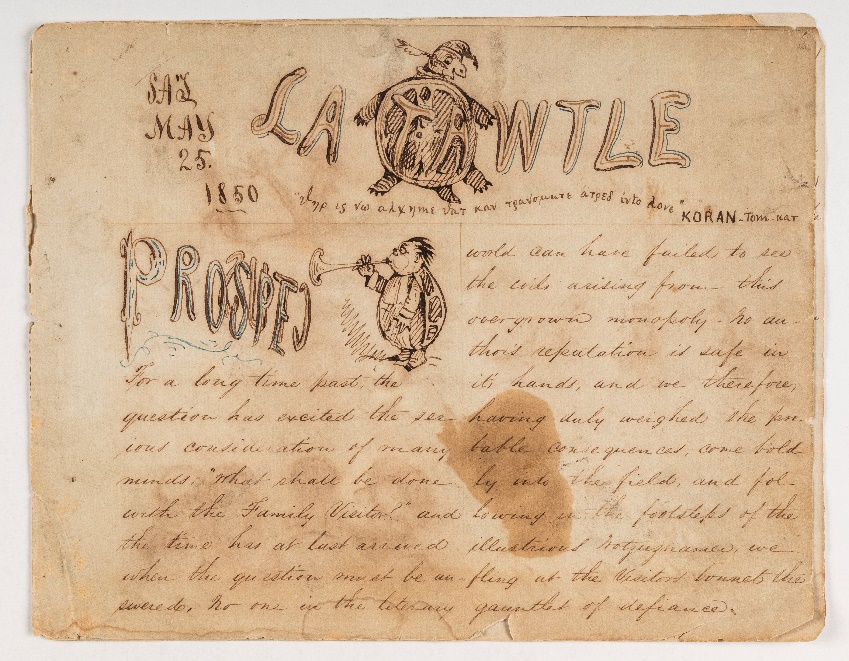Children adorned their newspapers with drawings and illustrations of many kinds. Most of these were original creations of the editors. They featured scenes from their stories and anecdotes, clues for their puzzles and riddles, fantastical characters, and depictions of historical events. They were done either in pencil or ink, and a few of them were colored. Good examples of these newspapers are La Tawtle, edited by an unknown editor, and The Parsonville Times and Woodside Gazette, edited by siblings James and Mary Bowne Parsons.
La Tawtle

La Tawtle was edited by an unidentified editor in 1850. It was the prospectus for the paper, which included international correspondence, poems, and quotes in various languages including French, Italian, German, Latin, and Greek. The editor also criticizes a rival newspaper at the time titled "The Family Visitor." The editor included several caricature drawings related to the writings, including a turtle, dogs barking at the moon, and faces of various men.
The Parsonville Times and The Woodside Gazette

The Parsonville Times and The Woodside Gazette were two separate newspapers that were edited and published by siblings James Bowne and Mary Bowne Parsons in 1856 and 1858, respectively. Their family was living in Flushing, New York, and that's where they published The Parsonville Times, in which they included poems, moralistic reflections, and writings about nature, travel, childhood, and family. The Woodside Gazette was initially published in Flushing but then was published in Litchfield, Connecticut when the family moved there in June of 1858. They included similar topics and formats in this new newspaper. In both newspapers, they included drawings depicting the scenes from their stories and anecdotes. One of them shows a scene of a horse drawn carriage, with the horse bolting off and pulling the cart towards a group of people around a market stand.
Flushing is a neighborhood located in Queens borough within New York City. It was founded in 1645 by Dutch settlers but was taken over by the English in 1664. During the 19th century, Flushing became a wealthy residential area with easy access to Manhattan. The oldest library in Queens County was built in Flushing in 1858 and the first public high school of New York City was established in Flushing in 1875. The town of Flushing was consolidated alongside other surrounding towns into the City of New York, forming Queens Borough in 1898. Farmland was further developed, and the area became a densely populated neighborhood.
Litchfield, Connecticut was originally called Bantam township and was incorporated in 1719, becoming the county-seat of Litchfield County in 1751. The first law school in the nation was established in Litchfield in 1784 by judge Tapping Reeve. The Litchfield Female Academy, a prominent institution for women's education, was founded in 1792 by Sarah Pierce. The town was the birthplace of famous people, including Ethan Allen and Harriet Beecher Stowe. During the mid-19th century, local industry and commerce began to decline and Litchfield gradually transformed into an agricultural town. Industrial interests moved to towns along the Naugatuck River, such as Torrington, Winsted, and Waterbury. By the late 19th century, Litchfield had become a popular summer destination for wealthy people from New York.
Suggested Classroom Questions and Activities
- How do the illustrations complement the stories and anecdotes in the newspapers?
- What scenes or characters did the editors choose to draw?
- What other scenes or characters could they have included?
Ask your students to create a short story or anecdote and draw an accompanying picture of a scene or character in their story.
(CCSS.ELA-LITERACY.RL.1.7 Use illustrations and details in a story to describe its characters, setting, or events.)
- Ask your students to describe their drawing to the class.
To expand, ask them to explain how their drawing relates to their story and how it helps to better illustrate their story.
(CCSS.ELA-LITERACY.RL.1.3 Describe characters, settings, and major events in a story, using key details.)